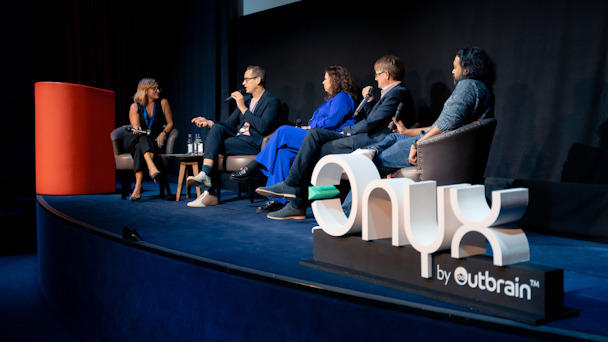Made you look: how brands can be attention magnets in a distracted world
In the first of a three-part series on the art and science of attention, we explore why consistent differentiation is the creative sweet spot for brands to stand out and engage with audiences in the digital age.

Leaders from Kantar, General Mills, Three UK and System 1 discuss reinventing creativity for a distracted world. / Oli Taylor
Made you look, made you stare…
As the childhood rhyme goes, the rest of that sentence is open to interpretation, but in the digital playground in which marketers are vying for attention, there is little room for interpretation.
Content saturation and fragmented media channels are leading to dwindling attention time on screen – making the job of a marketer even more difficult to seize and sustain interest from audiences. Ads today can’t simply appear; that’s not enough anymore. They must captivate genuine attention from audiences, while delivering an outcome that matters to the brand.
Attention is an art and a science. Every moment of engagement has the potential to make or break a campaign. Attention mechanics can be a game-changer, as the industry shifts its focus beyond superficial, KPI-focused metrics towards outcome-driven results.
For this series, we’re starting with the art – creating a story worthy of attention. And there are lessons from understanding the human brain that can be applied to the art of creating attention-worthy advertising that leads viewers beyond a glance to immerse in the ad narrative.
Advertisement
Attention grabbers!
The psychiatrist, neuroscience researcher, philosopher and literary scholar, Iain McGilchrist, writes of two different hemispheres of the brain which can be applied to different types of attention: broad and narrow beam. Speaking at Outbrain’s Captivate event, Orlando Wood, chief innovation officer, System1, referenced McGilchrist’s work as the basis for how the different parts of these brain mechanics drive different responses, and can be applied to driving attention in advertising.
“When you look at these two types of attention, you find that they look a bit like the two schools of advertising that have always existed – one that is more oblique, holistic and charming through an emotional appeal (right brain, broad beam) and one more direct and predatory (left brain, narrow beam),” he says.
For brand building efforts, he suggests that advertising should include people, characters, music, humor and metaphors, so people can join the dots themselves and embed things into their memory. Whereas for short term performance, narrow beam features are much more focused include things like short sharp cuts, words on screen, and rhythmic sound effects to drive direct effects.
Advertisement
When you’ve got attention, how do you keep it?
While these lessons can be applied to creative to drive specific outcomes for brands, what really captures the attention of today’s audiences, say experts, is having a consistent message that can evolve and adapt over time to firmly lock into the memory.
“Performance is often seen as the poor relation – it’s very price- and outcome-driven,” explains Deirdre Tippen, head of performance marketing & planning, Three UK. “But if you do it right – and it doesn’t have to be overly fancy – it can be really effective at driving brand metrics as well.
She explains that for a brand like Three, operating in a highly competitive market, it’s important that the brand is “single minded in what it is trying to sell for people to stay on message and understand exactly what it is that we’re trying to do”, using audio and visual cues that remind people of what it is, but in a way that evolves and changes. She adds: “What you do on TV is different to what you do on social, which is different to what you do on digital platforms – and that can be lost if you’re trying to have matching luggage”.
“Matching luggage kills campaigns”, adds Dom Boyd, managing director, UK Insights & Marketing Effectiveness Practice, Kantar, who points to data which shows that creative which is customized to the platform increases response rate and effectiveness by approximately 60%. He says: “It’s got to be integrated, true to the brand, and totally customized according to the context of the platform and the format within the platform as well.”
“The real breakthrough in online marketing lies in designing customized experiences that not only capture but also sustain audience attention,” says Faye Liddle-Moore, global head of Outbrain Brand Studio. “It’s not just about visuals; it’s about crafting stories that resonate deeply, serving them in contextually relevant placements as audiences are ready to explore something new. These principles are at the core of our Brand Studio mission to make the open web a richer space for both brands and audiences.”
Suggested newsletters for you
Consistent differentiation
Media fragmentation has driven the importance of having campaign synergies across different platforms – making context more important than ever for brands to be consistent and have a glue that ensures different activations stick together, says Boyd.
He continues, “the challenge is to have that consistent difference in a way that flexes and breathes across different contexts and environments – so that you’re not boring the pants off your audience. You’re not just competing with other ads, you’re competing with pop culture. If you don’t have that consistent difference, done in your own way, you’re essentially doing yourself a disservice.”
For General Mills, owner of staple cupboard brands including Cheerios, Annie’s, Nature Valley, and Häagen-Dazs, the company’s head of creative and growth Arjoon Bose says that things are “constantly chopping and changing” but that it always makes sure that “creative is consistent”.
Bose explains how General Mills uses a framework for creative attention internally which centers on relevance (to the lives of consumers), emotional response (making it personal and the element of surprise), distinctiveness (through artistic memory codes) and consistency. He stresses the importance of thinking about the range of emotion that is relevant and creatively honorable to the brand, and something they can creatively own and be memorable for.
“Lighten up,” Boyd says. “Humor is like creative crack. Listen to your gut, allow people the freedom to be creative with format, integrated with campaigns and executions, and just lighten the hell up.”
For creating ‘attention magnets’ – those rare gems of campaigns that seize and sustain viewer interest – the creative formula of relevance, emotion, context and consistency are key to driving the art of attention, while ensuring that the device that captures attention also tells the story.
Designed to maximize consumer attention and drive greater brand impact, Onyx by Outbrain offers a suite of creative video and high-impact display experiences to spark exploration and interaction.
For more highlights from Outbrain’s Captivate: the art and science of attention event, click here. And look out for part two of this series where we’ll delve deeper into the science of attention.
Content created with:

Outbrain
Outbrain (Nasdaq: OB) is a leading technology platform that drives business results by engaging people across the open internet. Outbrain predicts moments of engagement...
Find out more
